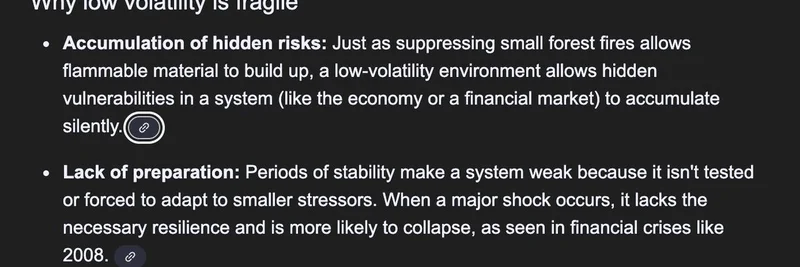In the fast-paced world of crypto, where fortunes can flip overnight, a recent thread from Jordi Alexander (@gametheorizing) sheds light on why things went south so quickly. If you've been scratching your head over the massive drop in open interest—from $15 billion to $6 billion on Hyperliquid alone—you're not alone. Alexander draws on Nassim Taleb's ideas from his book Antifragile to explain it all. Let's break it down in simple terms and see how this ties into the wild world of meme tokens.
The Illusion of Stability in Crypto Markets
Alexander kicks off by noting how crypto enthusiasts are buzzing with "What happened?" after a brutal market shakeout. He points out that this isn't necessarily due to a single villain like FTX or Luna collapses from the past. Instead, it's more akin to the May 2021 liquidation cascade. After months of upward trends and eerily low volatility—where prices don't swing much—people get complacent and pile on more risk.
Volatility, in crypto speak, is how much prices bounce around. Low volatility feels safe, like a calm sea, but Taleb argues it's actually fragile. Why? Because it suppresses small "fires" or corrections that would otherwise reveal weaknesses. Over time, these hidden issues build up, turning a minor shock into a full-blown catastrophe. Think of it like a forest where small fires are put out constantly; eventually, dry tinder accumulates, and one spark leads to a massive wildfire.
In recent months, with gold hitting $4,000 and stocks at all-time highs, even big gains in crypto felt insufficient because the U.S. dollar was weakening. This fueled more aggressive bets, including some downright silly ones. Alexander humorously calls out "retarded theses" like buying a coin because CZ's gardener's dog is named $ASTERIX—hello, BSC season vibes.
Hidden Risks in Perps and Shitcoins
Perpetual futures, or perps, have been all the rage as a narrative in crypto. These are contracts that let you bet on price movements without an expiration date. But as Alexander warns, the liquidity—the ease of buying and selling without big price shifts—isn't always there to back it up. People are using synthetic dollars as collateral, trading pre-market perps without reliable external references, and brushing off risks with casino analogies.
This is especially rampant in the meme token space. Solana traders flipping shitcoins on mobile wallets via Phantom app are hyping perp DEXes (decentralized exchanges) valued at billions, often without grasping the underlying fragility. Meme tokens thrive on hype and FOMO (fear of missing out), but when liquidity dries up, it's game over. Founders chasing token prices as their KPI (key performance indicator) instead of building resilient products only amplify this.
Taleb's antifragile concept flips fragility on its head. Fragile systems break under stress, robust ones endure, but antifragile ones actually get stronger from chaos. Crypto, particularly memes, often falls into the fragile category because low-vol periods hide risks like over-leveraging and poor liquidity.
Lessons for Meme Token Enthusiasts
For those deep in meme tokens, Alexander's thread is a wake-up call. The influx of liquidity made every launch seem like a sure win, masking the brittleness beneath. Retail investors FOMO-ing in without due diligence, combined with founders prioritizing hype over robustness, sets the stage for these crashes.
But it's not all doom. Alexander acknowledges the tightrope walk: Skip the hype, and you might miss out or fade away. Jump in blindly, and you get wrecked. The key is balance—embracing some volatility to stress-test your positions and projects. Taleb's wisdom reminds us that true strength comes from systems that benefit from disorder, not hide from it.
If you're building or trading meme tokens, focus on antifragility: Diversify, manage leverage wisely, and prioritize real utility over pure speculation. As Alexander puts it, maybe dusting off that Antifragile book isn't a bad idea amid the chaos.
Check out the original thread on X for the full scoop, including replies debating everything from specific trades to Taleb's relevance in crypto.
In the end, crypto's volatility isn't the enemy—it's the prolonged calm that should make you wary. Stay vigilant, and turn those shocks into opportunities for growth.



